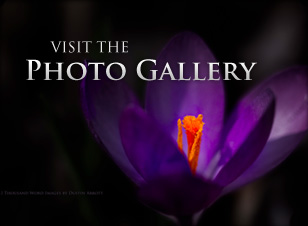Viltrox AIR 15mm F1.7 X Review
Dustin Abbott
July 30th, 2025

Viltrox’s AIR series has become a favorite of a lot of APS-C photographers for a very good reason. These lenses have all punched way above their weight optically, and while the build formula is simple, these have all been very lightweight, well built, inexpensive lenses. The early lenses in the series have covered standard focal lengths like 35mm, 50mm, and 85mm full frame equivalents, but things are about to get interesting for this series, as, for the first time, we are seeing an unconventional focal length. The most recent AIR lens is the Viltrox AF 15mm F1.7 AIR, and this is a very interesting development as it gives photographers a potential lightweight wide angle prime to pack along for relatively little money ($239 USD or less, if you use the coupon code “DUSTINABBOTT” at Viltrox!). Is it worth checking out? Find out my thoughts by watching the video review below or reading on in the text review.
Follow Me @ YouTube | Patreon | Instagram | Facebook | DA Merchandise | Flickr | 500px
Thanks to Viltrox for sending me a review loaner of this lens. As always, this is a completely independent review. *The tests and most of the photos that I share as a part of my review cycle have been done with the APS-C mode (26MP) of my Sony a7RV camera. You can visit the product page for the 15mm F1.7 AIR here.
__________________________________________________________________________________________________
Viltrox AIR Series Reviews:
- Viltrox AF 20mm F2.8 (full frame)
- Viltrox AF 40mm F2.5 (full frame)
- Viltrox AF 50mm F2 (full frame)
- Viltrox AF 15mm F1.7 (APS-C)
- Viltrox AF 25mm F1.7 (APS-C)
- Viltrox AF 35mm F1.7 (APS-C)
- Viltrox AF 56mm F1.7 (APS-C)
__________________________________________________________________________________________________
15mm doesn’t correspond to a typical focal length and lands at a 22.5mm full frame equivalent after you account for the 1.5x crop factor of Fuji X (tested here), Sony E , or Nikon Z APS-C cameras. That’s a little narrower than a 20mm equivalent lens, though wider than the 24mm standard. Fuji doesn’t have a 15mm prime lens, though they do have a 14mm F2.8 along with 16mm F2.8 (my review here) and 16mm F1.4 options. Sony does have a 15mm lens, however, in the form of the 15mm F1.4 G (my review here). Most of these lenses cost $800+, so once again Viltrox is going to be in a position to really be a disruptor on the price front.

While the focal length might not be purely conventional, it is very useful. This is an effective wide angle look at the world without hitting the extremes that add a lot of distortion. The AIR 15mm can produce dynamic images that fits a lot in the frame.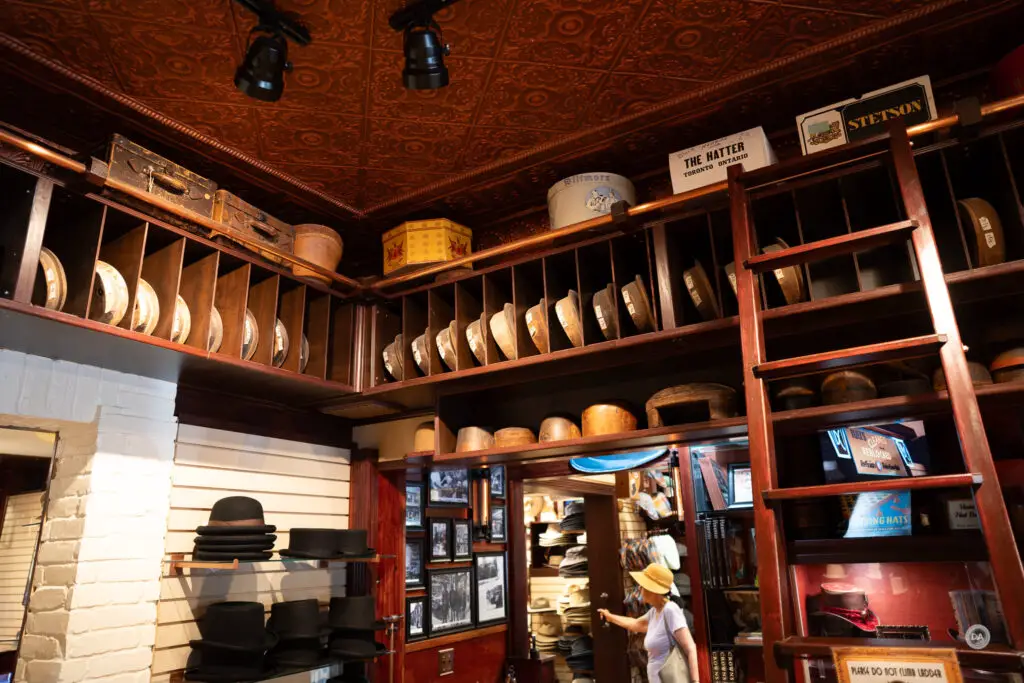
Much like Samyang’s “Tiny series”, this lens is for those who don’t care about bells and whistles and just want a lightweight, high performing lens. This won’t be the series for those looking for aperture rings or other features, but if you want a light, tough, high performing lens at a great price, prepare to be delighted with the new AIR 15mm.
Sound interesting? I suspect so, so let’s dive in a little deeper into the details.
Viltrox AIR 15mm F1.7 Build and Handling
The first thing to note is the slightly unusual maximum aperture value. We’ve seen that there are lenses with F1.4 aperture in and around this focal length (including a Sigma 16mm F1.4 that I reviewed here) along with F2.8 lenses. F1.7 is 1/2 stop slower than F1.4, but is 1 1/2 stops brighter than F2.8. F1.7 is a very useful aperture brightness in a wide angle lens, particularly considering how compact the AIR 15mm is. I suspect a lot of people are willing to tolerate 1/2 stop less light gathering if an F1.4 alternative costs 3x as much.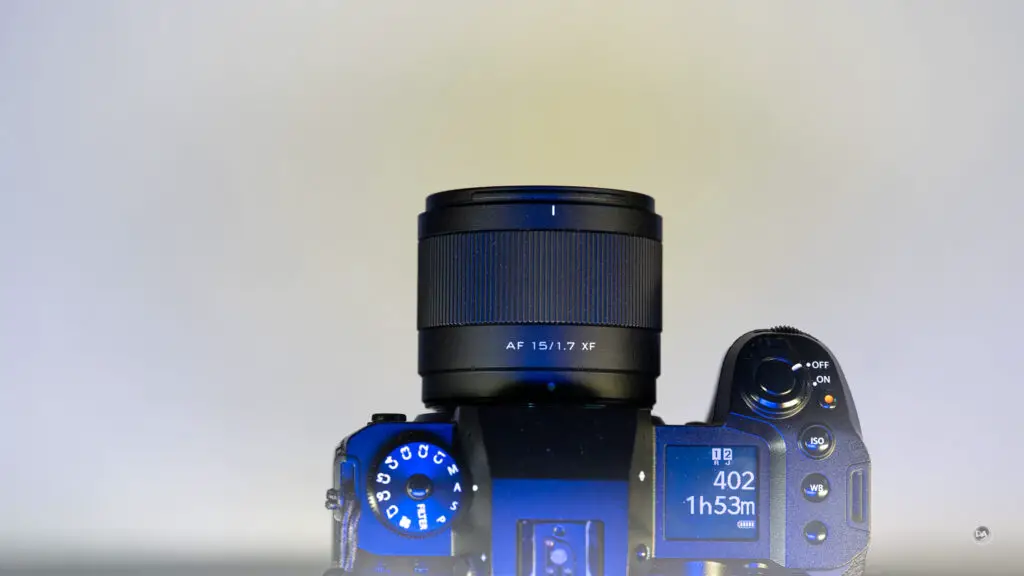
The AIR series eschews the heavier metal casing typically used for the earlier Viltrox lenses and embraces a more conventional, lightweight design in polycarbonates (engineered plastics). I wouldn’t call the build high grade here, but what I can say is that nothing about the plastics feel flimsy. These lenses feel tough and durable, and thus far that’s just what they’ve been in my experience (I’ve owned some for a few years now).
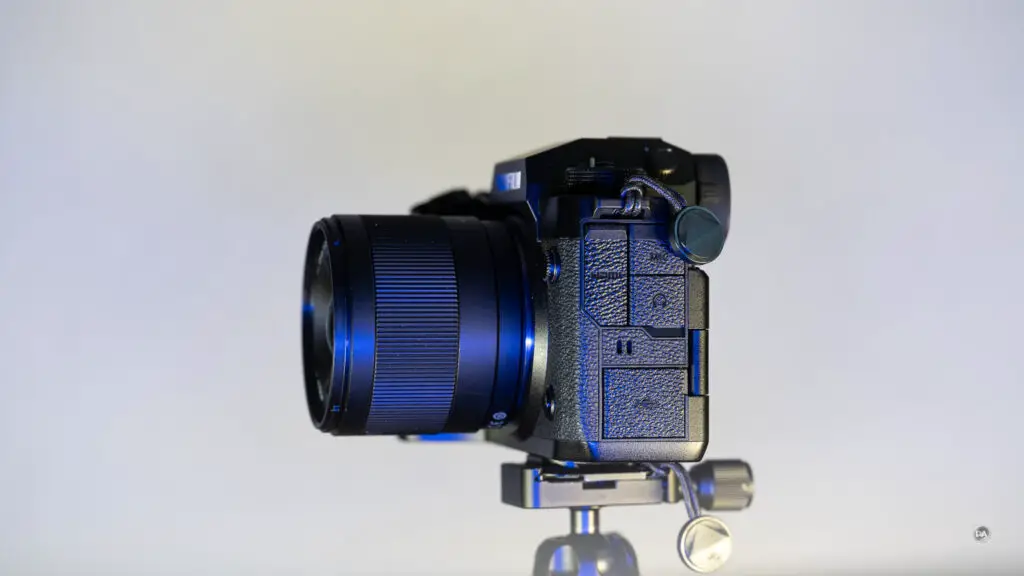
The new AIR 15mm F1.7 is extremely compact, only 65mm in diameter (2.55″) and 56.7mm in length (2.23″), making it pretty much identical in size to previous APS-C lenses from the AIR series. It weighs only 180g (6.34oz), making it very slightly heavier than previous AIR lenses but still extremely light. That is definitely lighter than all of the alternate lenses I’ve tested, and, in the case of a lens like the Sigma 16mm F1.4 (405g), it is less than half the weight. You can see that the AIR 15mm is just a tiny bit bigger than the AIR 35mm that I happen to have in Fuji X-mount.
That makes for a very compact profile on your camera. My Fujifilm X-H2 is actually a fairly large camera, so the AIR 15mm looks small on the body.
Up front we have a 58mm filter thread, which is a nicely common filter size. The front of the lens fascia has a variety of information imprinted on it and has a classic profile. I’m a fan of having some lens information on the front fascia, as I feel it adds character to the lens.
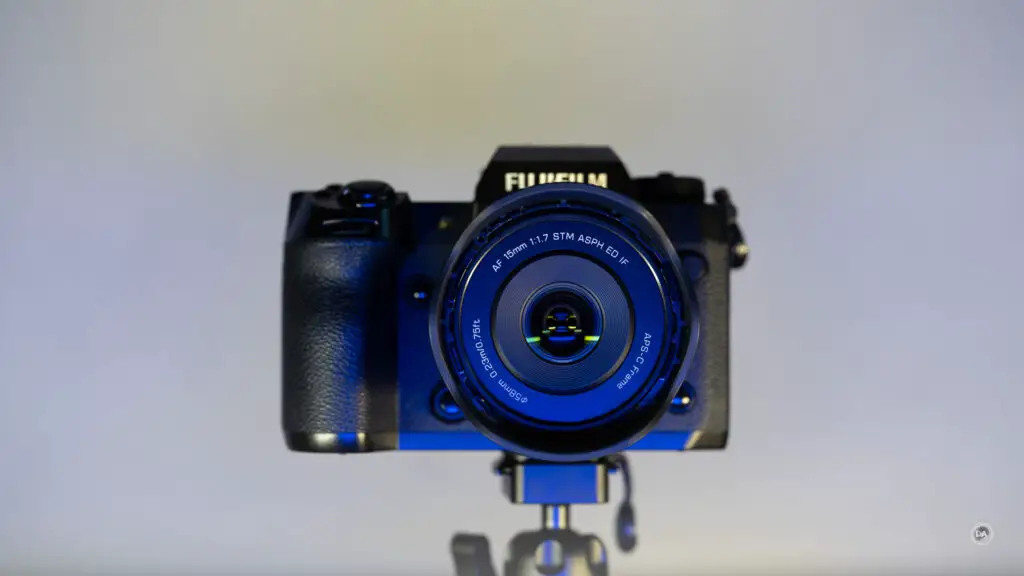
There is an included lens hood that is pretty shallow to prevent vignetting. It is much slimmer than those found on the 25mm and 35mm AIR lenses. I found that aligning the hood to mount it could be a little fussy, but the hood locked into place with good precision and didn’t move even when I walked around with the camera and lens on a strap.
A lens pouch is also included. The pouch doesn’t add a lot of protection value, but, like the hood, at least it is included. There are many more expensive lenses that include neither a pouch or a hood.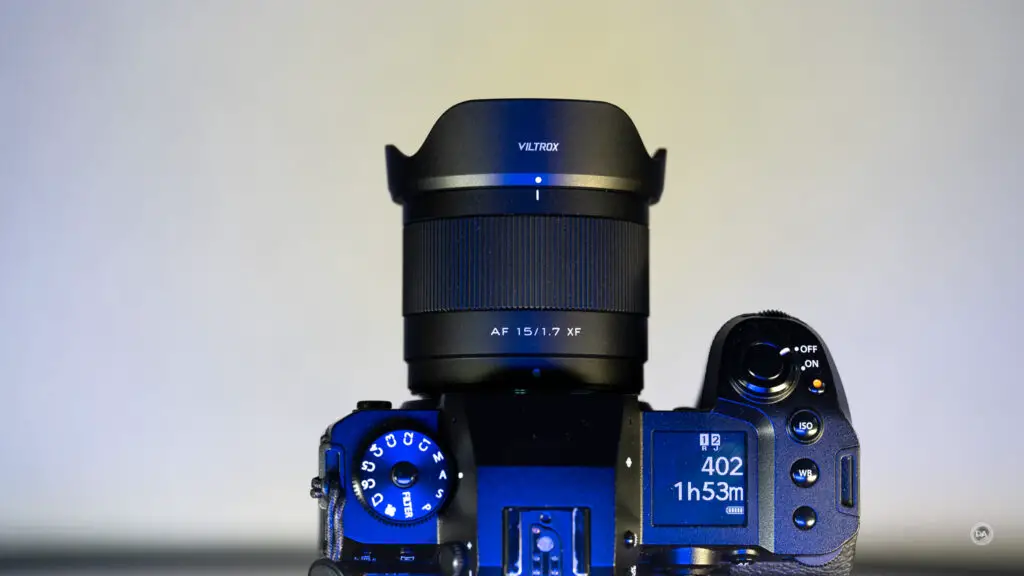
Fuji shooters in particular will be disappointed to find that there is no aperture ring, as is the case with all the AIR lenses. There are no switches, either. The only feature on the lens barrel is a wide manual focus ring. The manual focus ring has a nice amount of damping and moves smoothly. All manual focus aids (including automatic magnification of the focus area) will work with the Viltrox. The focus ring on the copy I tested on Fuji felt a little “gritty”, and I could detect a tiny bit of lag. I also had an E-mount version on hand as well, and I found that the focus ring on that one felt better and focus was more precise. The negatives are probably more of a Fuji thing.
The Viltrox AIR 15mm has 9 blades in its aperture iris. When stopped down far enough, an 18 bladed sunstar will emerge.
It is not the prettiest sunstar that I’ve ever seen, but it doesn’t look bad, either.
We have an important Viltrox standard in the form of a USB-C port on the metal lens mount that allows you to connect the lens to a computer and update the firmware directly. The firmware update process is very simple; just unzip the upgrade folder, drag the firmware update file to the folder that shows up when the lens is attached to the computer, and the update is done in seconds.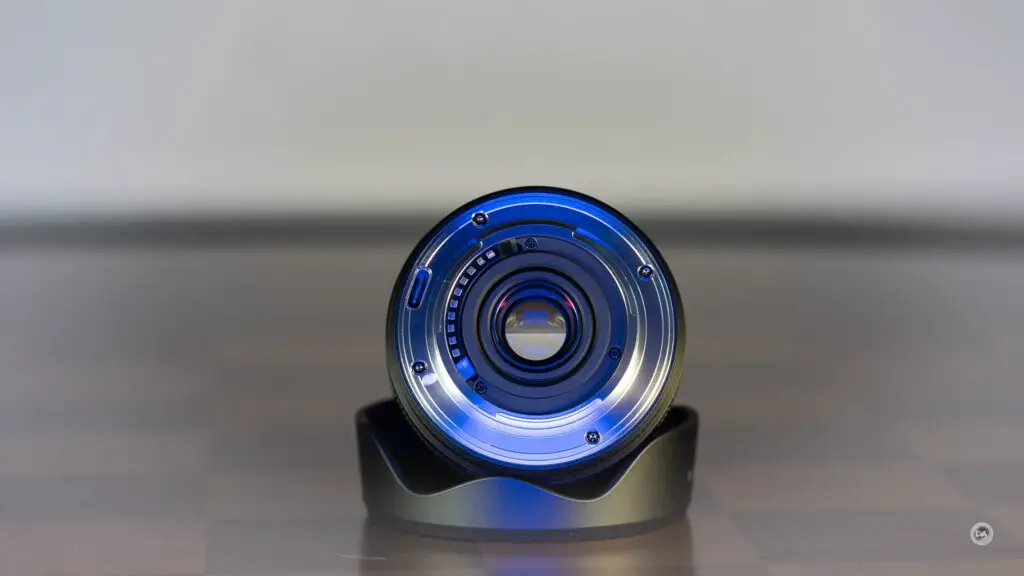
You can focus only as closely as 23cm, which isn’t particularly close for a 15mm lens. The Sony 15mm G can focus as closely as 17cm, for example. The resulting magnification is low, hovering around 0.10x. Here’s what that looks like:
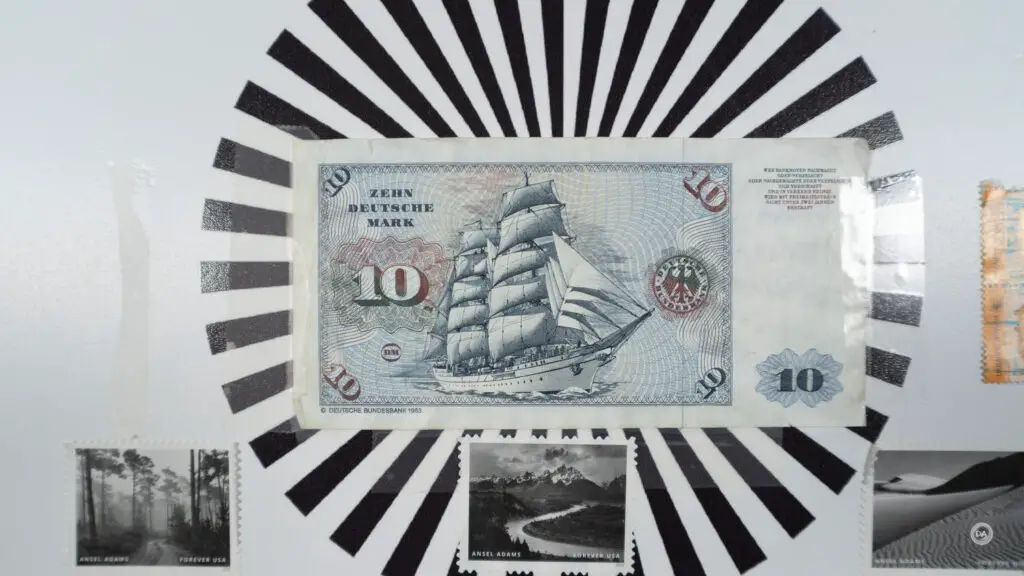
Don’t buy this lens to do macro type work, as you’ll definitely be disappointed. Close up image quality is not bad, but that’s not really this lens’ strength.
Viltrox’ more expensive lens series have weathersealing, but the budget AIR series does not. The AIR 15mm does have a HD Nano multilayer coating with water-resistant and antifouling coating on the front element.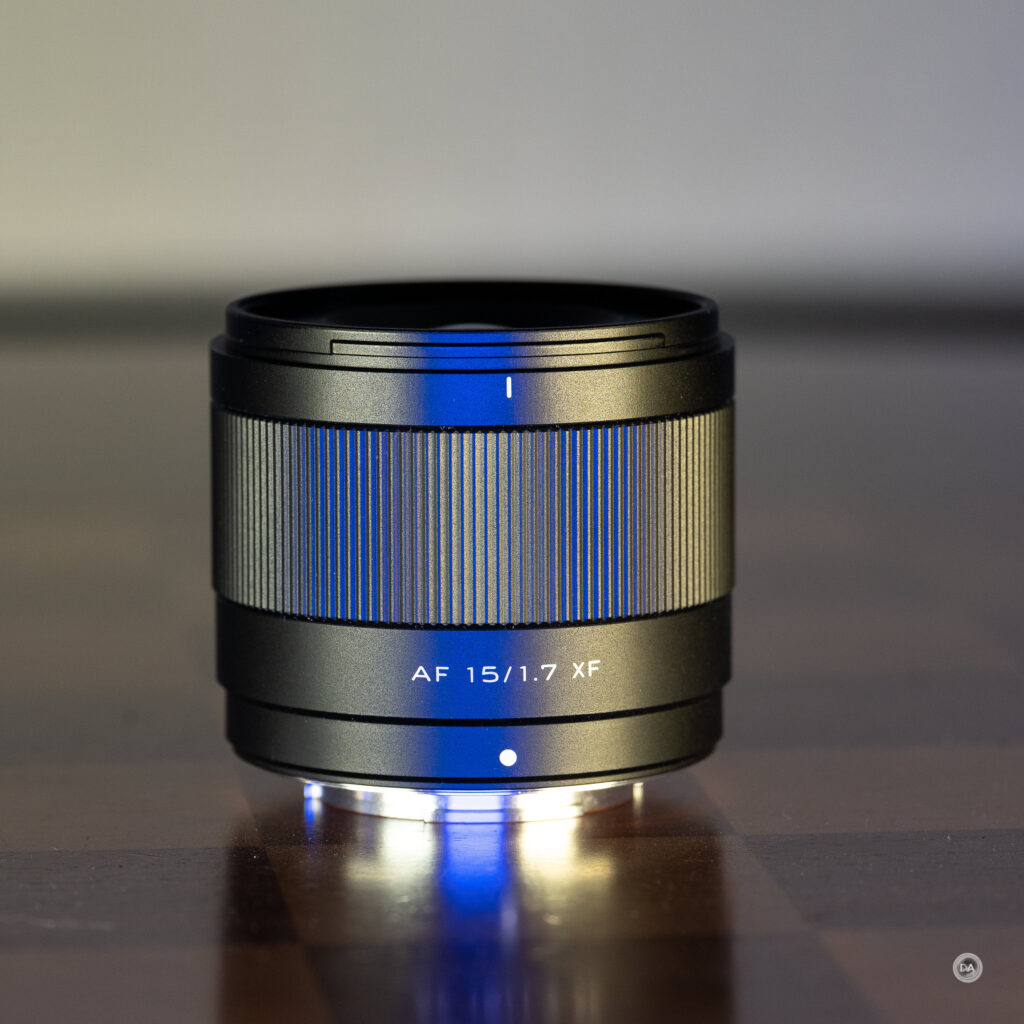
Though the AIR series is short on bells and whistles, the Viltrox AF 15mm F1.7, like other lenses in the series, feels sturdy and well made. It is lightweight, will balance easily on a wide variety of camera bodies and sizes, and doesn’t really feel “cheap” in any way.
Viltrox AF 15mm F1.7 STM Autofocus for Stills
The Viltrox AF 15mm F1.7 STM, like other AIR lenses, utilizes a lead-screw type stepping focus motor (STM) that makes for fast and quiet focus changes. Focus felt silent unless I put my ear up next to the barrel, and even then I could hear only a tiny little whine. On Fuji I could faintly hear the aperture iris blades click open and closed, too, though this isn’t loud. Focus speed is pretty good, with most normal focus changes happening near instantly, though with a major focus change you’ll sense a split second of lag.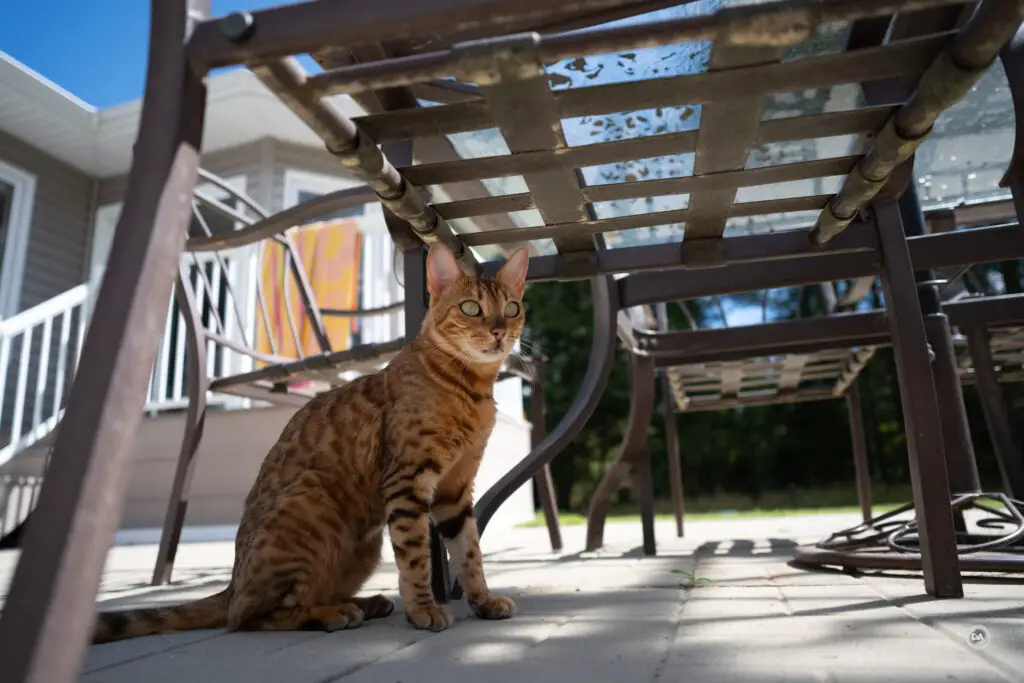
Fuji shooters are accustomed to hearing this, but since I have the Sony E-mount version, too, I tested AF side by side and there is no question that the lens is snappier on E-mount. Fuji’s hardware is due an upgrade.
That being said, the lens focuses well on Fuji, and, as you can see from this crop of the image above, focus is accurate as well.
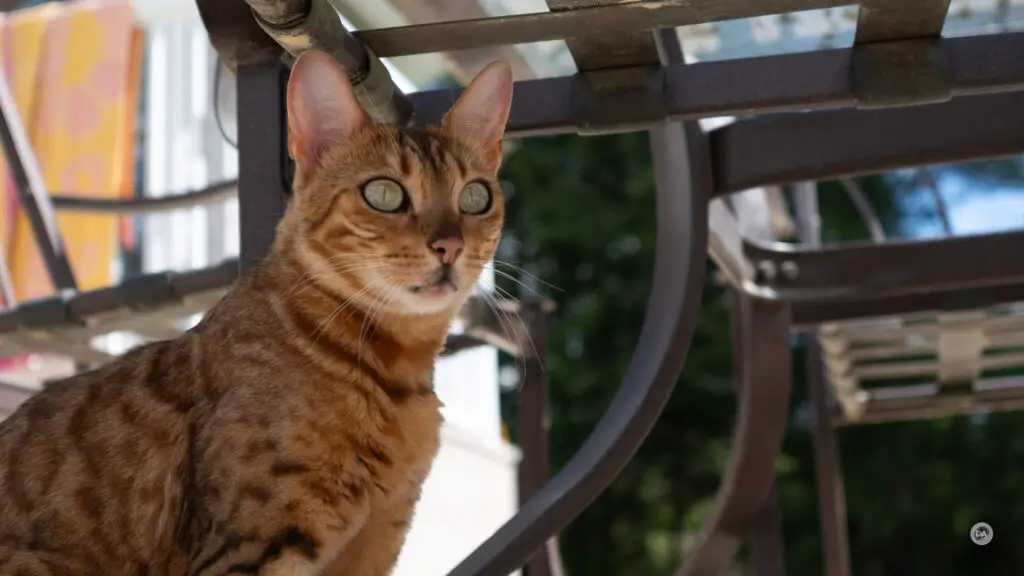
I was able to snap a quick photo after some ladies asked my wife to take a photo of them on the street with their phone. Even though I had to very quickly grab the shot, it is accurately focused.

More ordinary photos requiring less speed or precision are obviously fine.
The only time I can recall ever getting any slowdown or focus issues was with this shot of my wife in the doorway of a church we explored while on vacation. It was very bright, while she was somewhat shadowed in the opening. At first I was getting a red box, but then realized that I was shooting at F9. Opening the aperture up a bit resolved the problem, and I got an accurately focused photo.
Sony shooters wouldn’t see a similar issue, as Sony cameras will typically open the aperture while focusing.
Still, in general I felt like focus was really solid. I’ve definitely tested Fuji branded lenses that didn’t focus nearly as well.
Focus for Video
Video AF is typically a mixed bag on Fujifilm, as this is the area where the camera’s AF system struggles the most (at present). Video AF on the Viltrox AIR 15mm was pretty much par for the course.
Focus pulls weren’t bad, as while they didn’t move quickly, they had a nice level of damping and I didn’t have issues where touching a focus point on the LCD produced no result (an unfortunately common issue on Fuji). There is some focus breathing, but it isn’t extreme.
My hand test (where I alternately block the camera’s view of my face with my hand and then remove it) wasn’t great. There was a general lack of confidence, with focus racks sometimes in the wrong direction and moments when neither my hand nor my face was in focus.

Static shots were all good and stable. I had no issues with focus moving around and not staying solid.
Overall I would say that video AF was about average for Fuji. These AF tests were much more confident on Sony E-mount.
Viltrox AF 15mm F1.7 Image Quality
The Viltrox AF 15mm F1.7 has an optical design of 12 elements in ten groups, which is slightly more complex than the 35mm. A whopping 8 of these are exotic elements, including 3 ED (extra-low dispersion) elements, 3 HR (high refractive index) elements, and two aspherical element as a part of the design. The MTF looks mostly good, with an extremely sharp center, good midframe, but some drop-off near the corners.
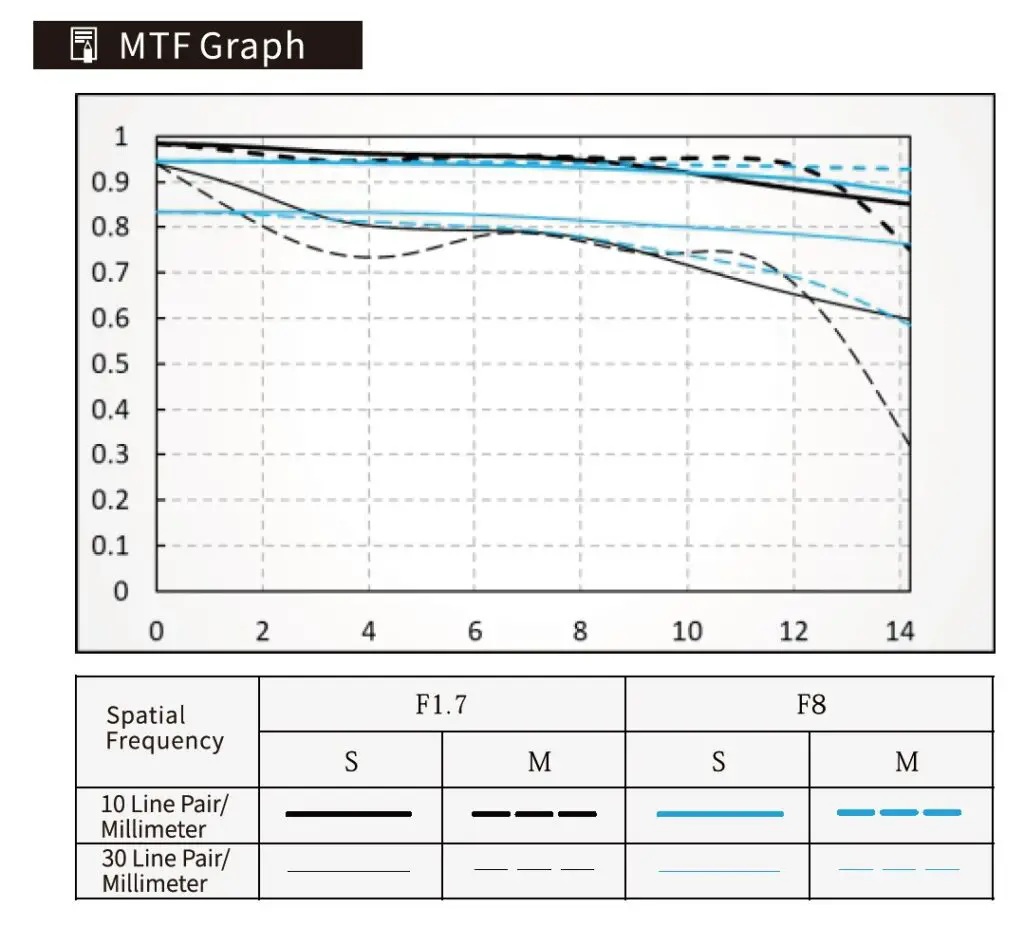
The MTF also shows the F8 performance, which is not as sharp in the center, but about the same in the midframe and better in the corners.
It is always worth mentioning that Fuji’s 40MP APS-C sensor is the most demanding platform that I test lenses on. A full frame sensor with equivalent pixel density would be over 90MP. That means that any optical weaknesses become very obvious on this sensor, and I’ve found a lot of lenses a bit disappointing on it. This isn’t really one of them, fortunately.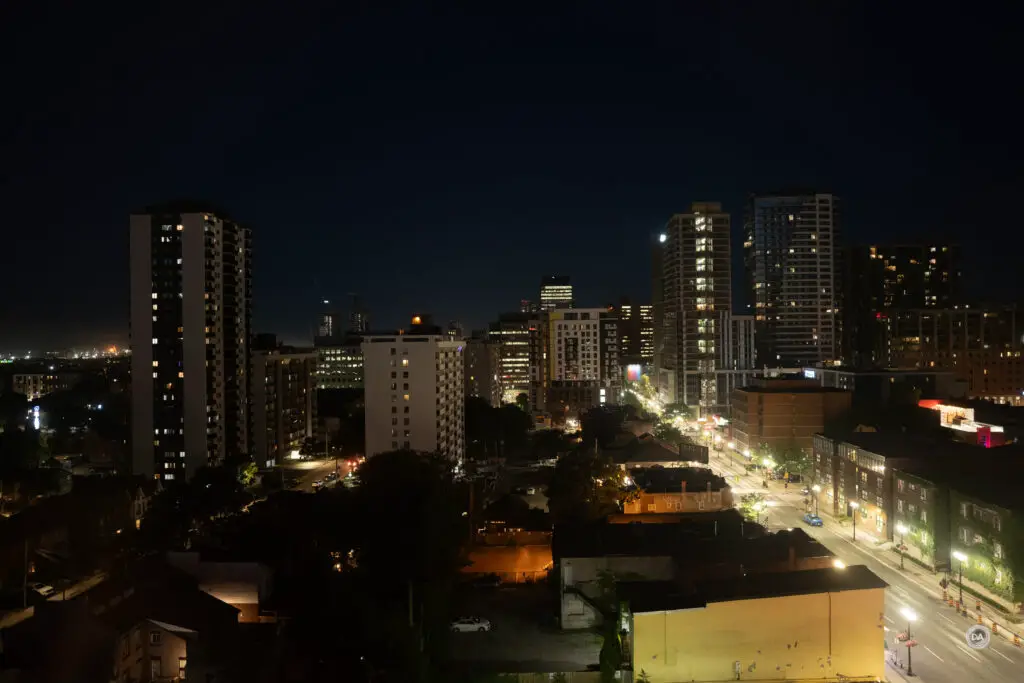
I had a nice mix of shooting environments with this lens, from my typical nature based photography to street and some people-based photos. I got good sharpness for most subjects even at F1.7, like here:
Before we jump into an evaluation of the optical performance, let’s take a quick look at the full frame coverage of the lens. I can’t do that when I’m testing the AIR lenses on Fuji, but since I also have an E-mount version on hand, here’s a look at the full frame coverage.
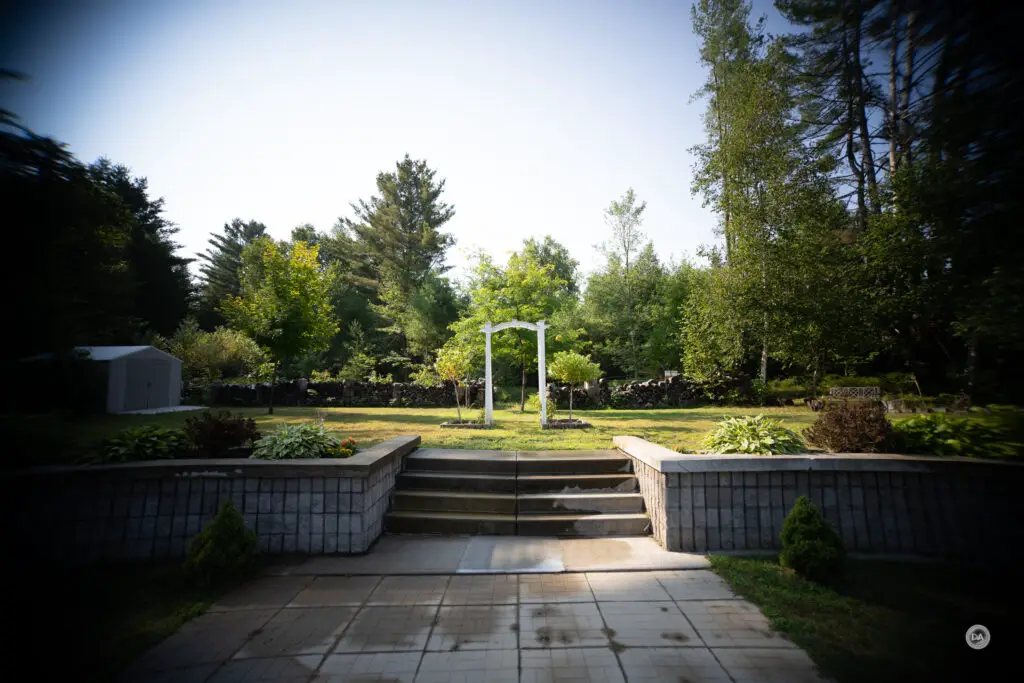
It is very reminiscent of what I saw from the 25mm F1.7. You can see some “hard vignette” in the corners where light is completely blocked from the sensor. If I crop all of that area out on a Sony 61MP sensor, I end up with about 36MP of usable image compared to the 26MP crop.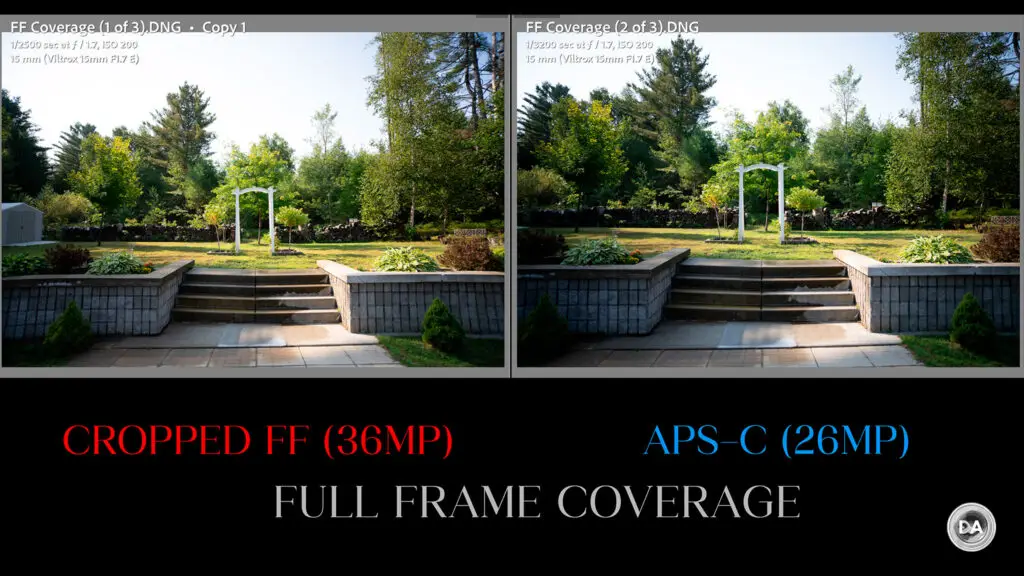
This isn’t quite as useful as what I saw from the 25mm (I could get about 45MP of usable image out it), but there’s enough to be useful to some people in some situations. Corner resolution even at the APS-C crop isn’t great, however, so going wider will result in some very soft performance in the extreme corners. I would mostly treat this as the APS-C lens that it is.
We’ll work through the chart results by first looking at distortion and vignette. 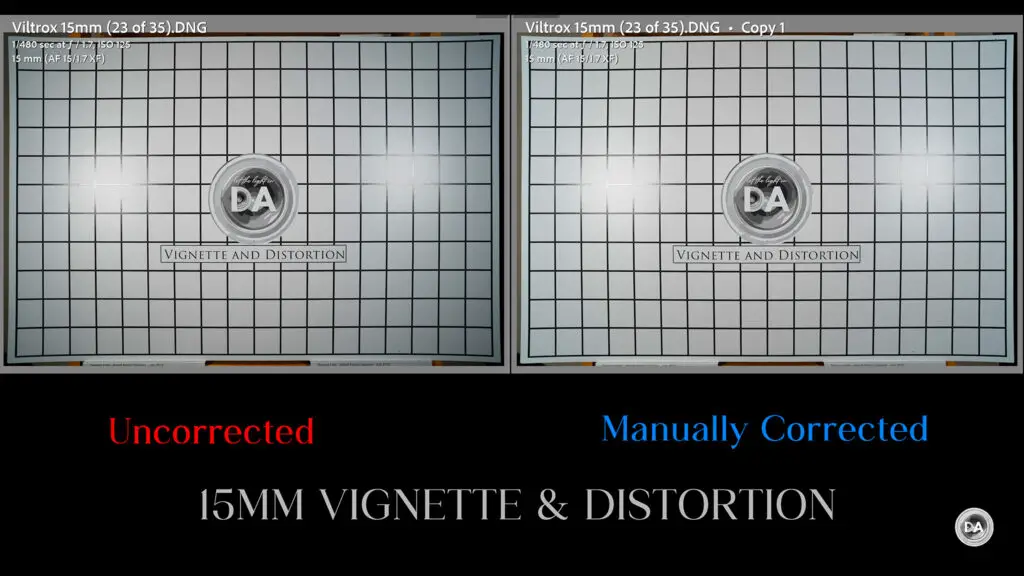
There is very little distortion, though what is there is slightly complex. In the example above, I used a -2 to correct a tiny bit of pincushion distortion, but that actually caused a bit of barrel distion and never really corrected the corners. The lens profile will do a better job with correcting it. Vignette needed about a +59 to correct, which is a normal amount, though a manual correction leaves a bit of discoloration in those corners.
Both the distortion and vignette are mild enough to be left without corrections in many situations. Here’s an F1.7 shot without any corrections, and while you can see the sky is darkened a bit in the corners, the image largely looks natural.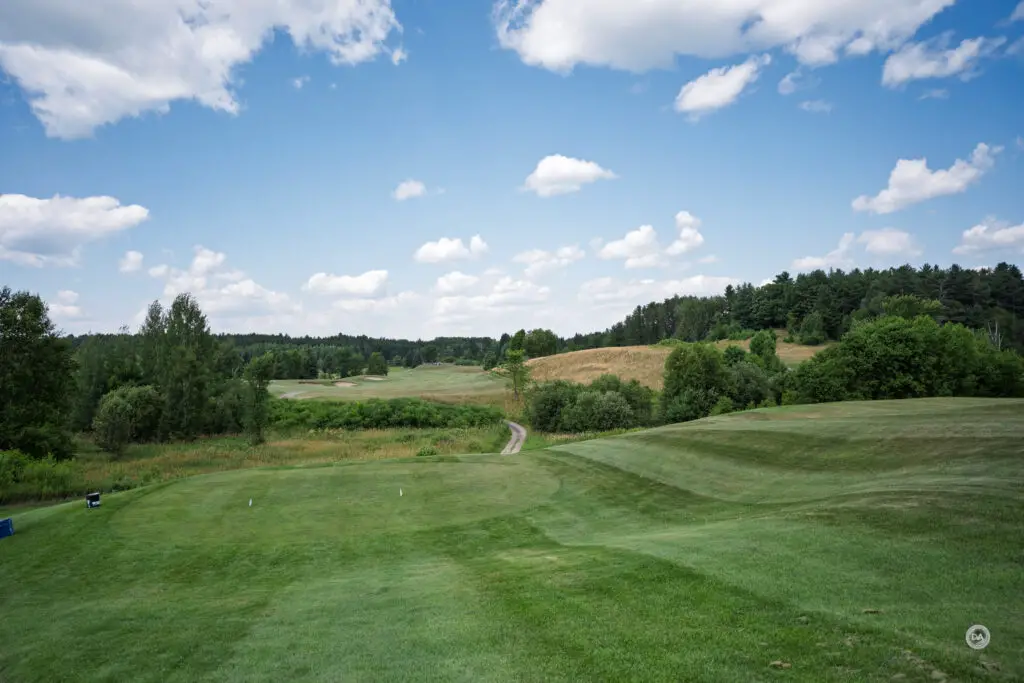
When I shot this image from a hotel window, I was high enough to be able to level the sensor and avoid keystoning. You can see that distortion isn’t an issue, however, with lines looking straight.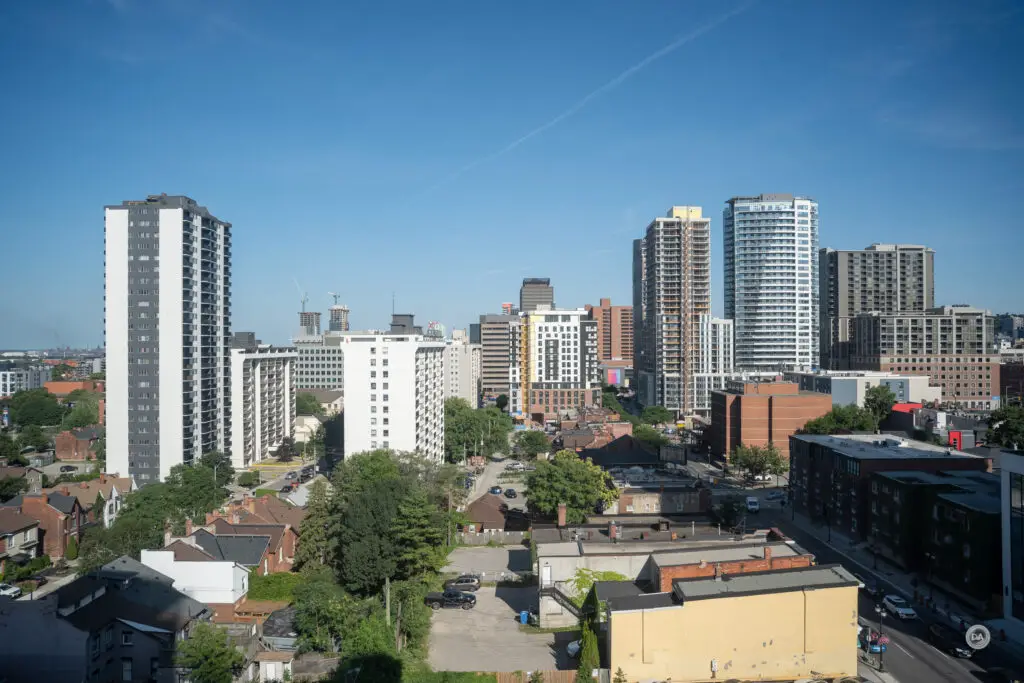
Viltrox typically does quite well in controlling fringing in their lenses, and that’s largely true here. I do see a bit of fringing before and after the plane of focus (Longitudinal Chromatic Aberrations, or LoCA), but the real world situations that you’ll see that with this focal length will be few and far between.

Lateral Chromatic Aberrations usually show up along the edges of the frame as fringing on either side of high contrast areas (like bare branches framed at the edge of images). This is far more likely to be an issue on a wide angle lens like this, but fortunately there really isn’t anything to see here.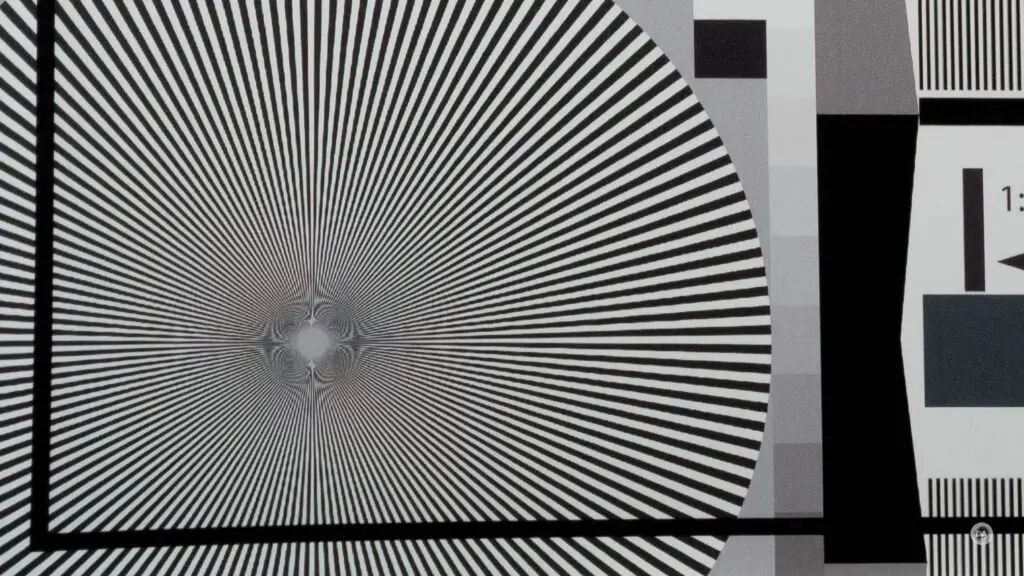
I also didn’t notice any issues around windows, which can be another challenge because there will often be fringing present there.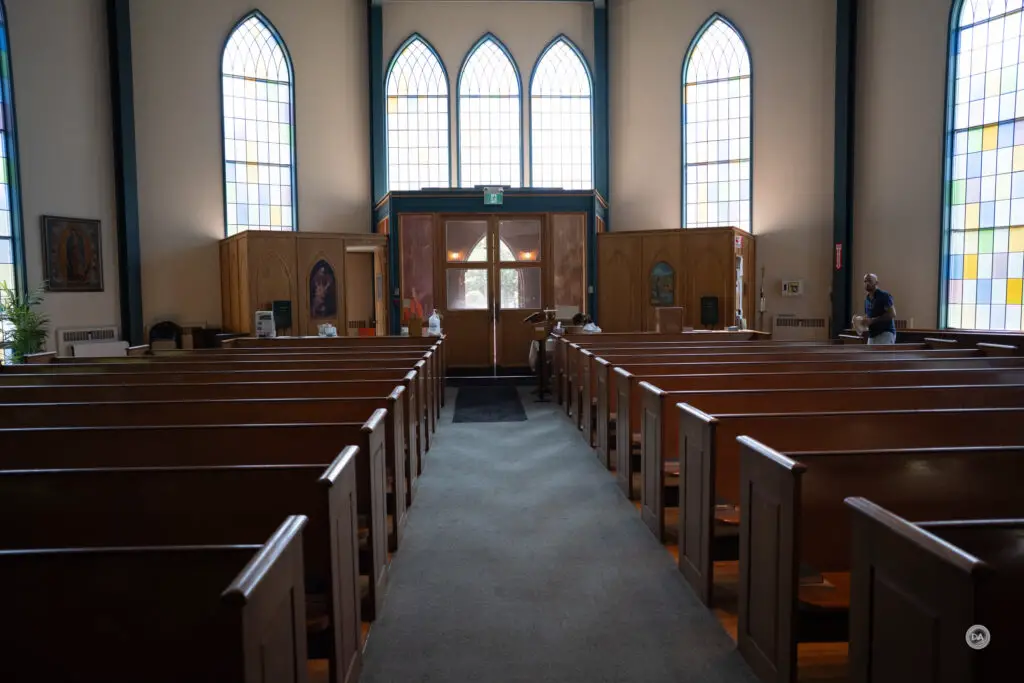
So how about resolution and contrast? All chart tests done with the Fujfilm X-H2 and its 40MP sensor using a tripod and a two second timer. Here’s a look at my test chart:

And here are the crops (at roughly 200% magnification) from the center, mid-frame, and extreme corner at F1.7:


This is pretty much exactly what the MTF suggested, with excellent center, good midframe, and much softer corners. Anything within the rule of thirds looks excellent even on this very demanding sensor. The corners are another story.
We can see that if we compare real-world F1.7 and F5.6 shots in the center, there isn’t much difference.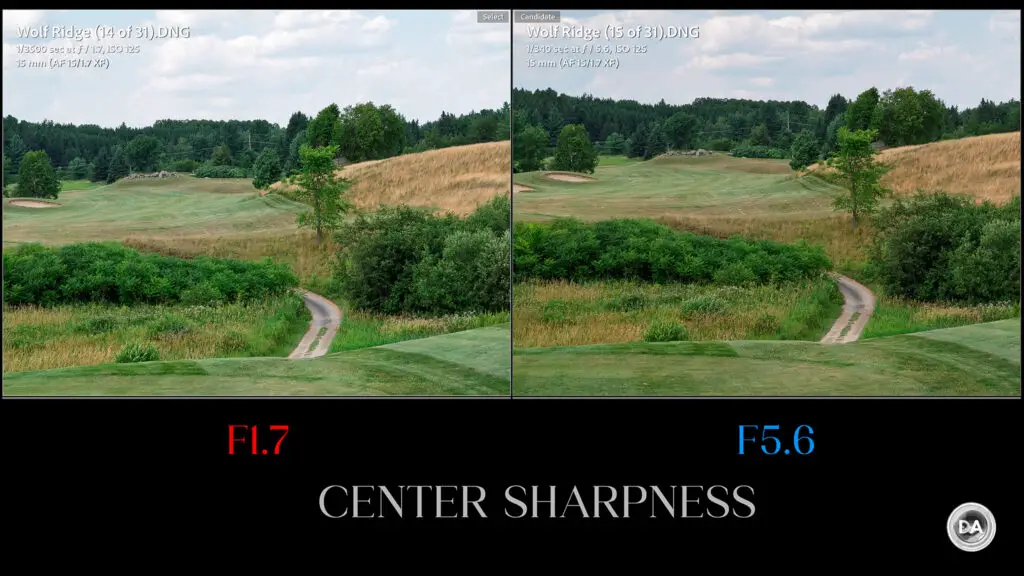
If we look over to the corner/edge instead, however, we see a significant difference not only in contrast but in the rendered details.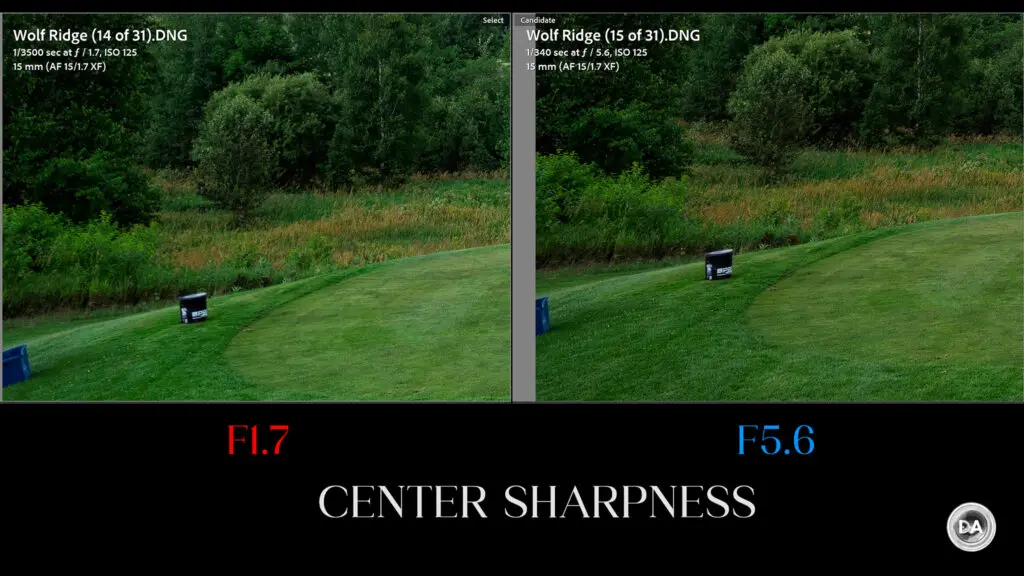
This lens has no problem with Sony’s 26MP resolution, and I would say that it is strong enough to handle Fuji’s 40MP APS-C sensor as well, as I’ve found both the 35mm and 56mm AIR lenses to be solid on that platform.
Stopping down F2 gives a very mild (and not meaningful) boost of contrast. There’s a bit more at F2.8. Noticeable corner improvements don’t really arrive until around F5.6:
Shooting between F5.6 and F8 will yield the best results for consistency across the frame, with real world shots largely being quite good everywhere.

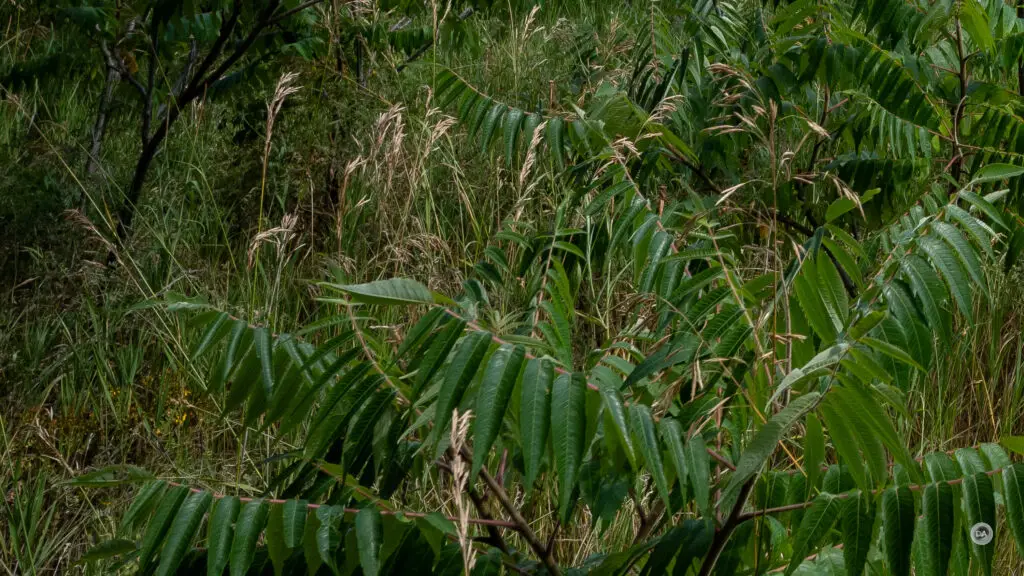
This is definitely a strength for the Viltrox AIR series generally, as the ability to get sharp results on such a demanding sensor from such an inexpensive lens is impressive.
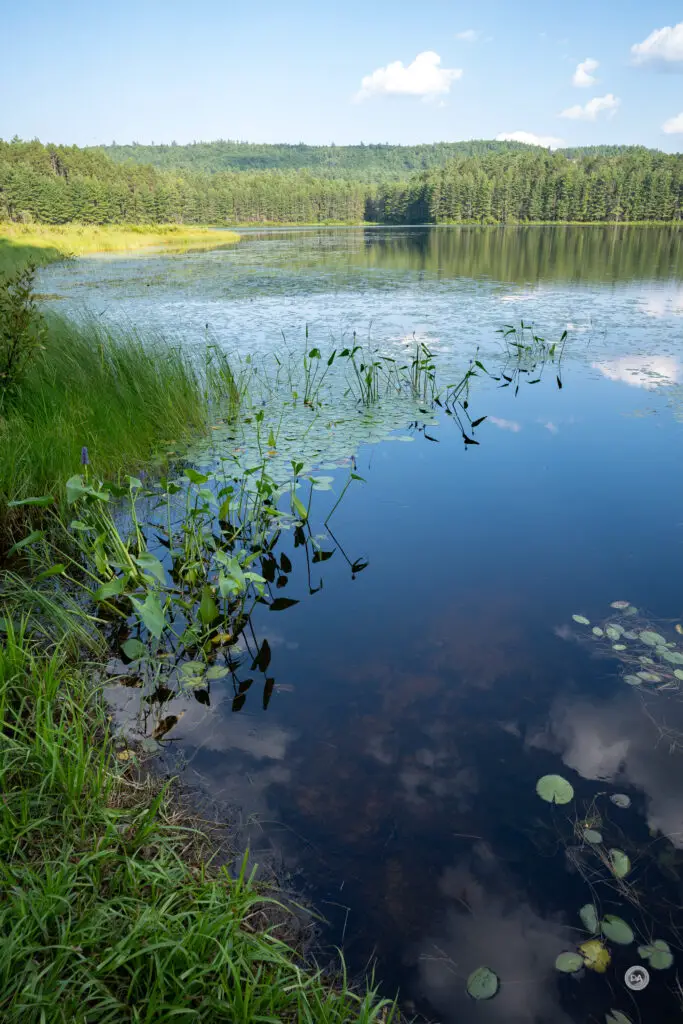
Diffraction isn’t quite as militant on the Sony 26MP sensor as it is on the Fuji 40MP sensor, but you will still definitely see a softening effect at F11, with it becoming more pronounced at F16.
I found this lens a joy to do walkaround photography with, as it delivered good looking images with nice detail and contrast.
I’ve been noting the improvement to Viltrox colors over the past two years since they switched suppliers for their optical glass. Once again I’m very happy with the color rendition from the lens, which feels neutral in color balance, nicely saturated, and with good contrast levels in the colors. It’s a good match for Fuji’s color science.
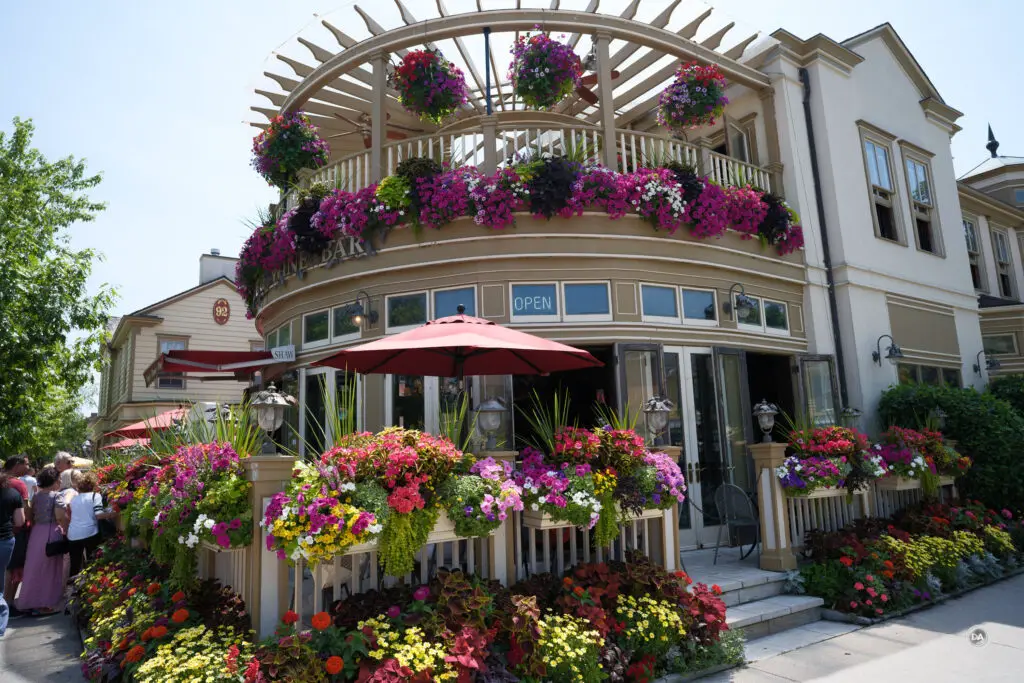
The one exception can be when flare disrupts things a bit. Colors look a little different in some backlit situations, like here.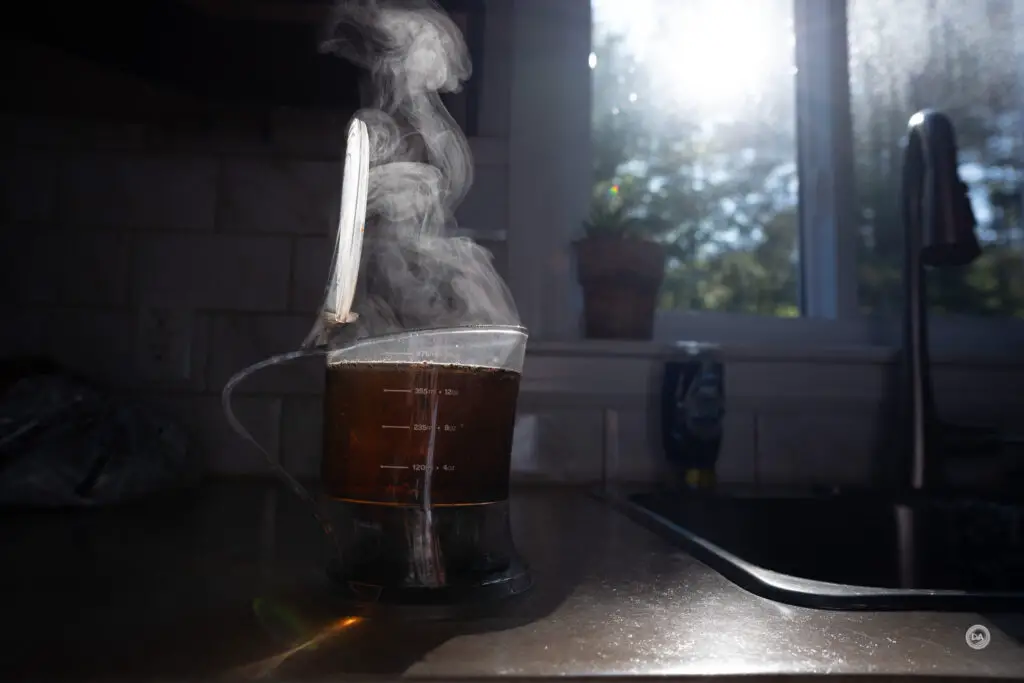
Flare resistance isn’t bad shooting right into the sun, but it can be a little vulnerable (particularly at smaller apertures) if the sun is located in the corners or right out of frame.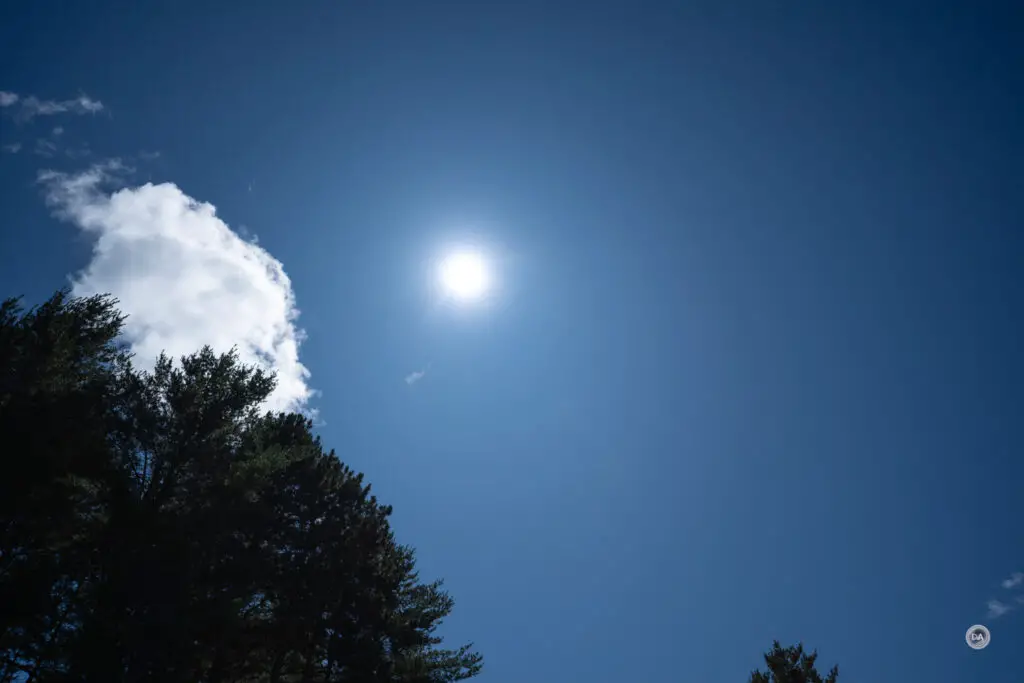
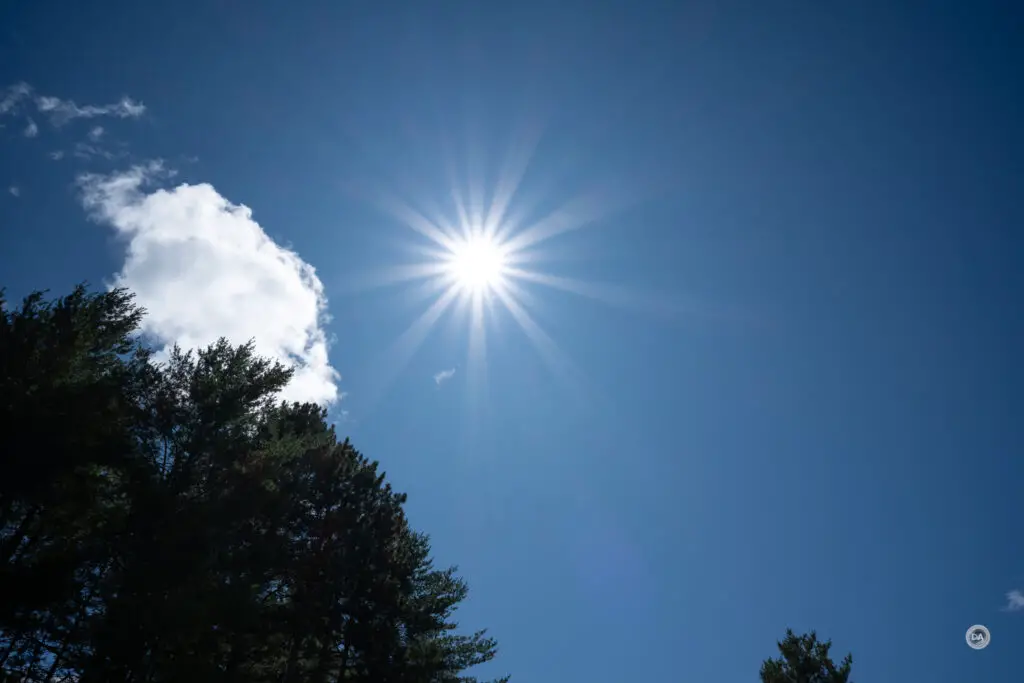
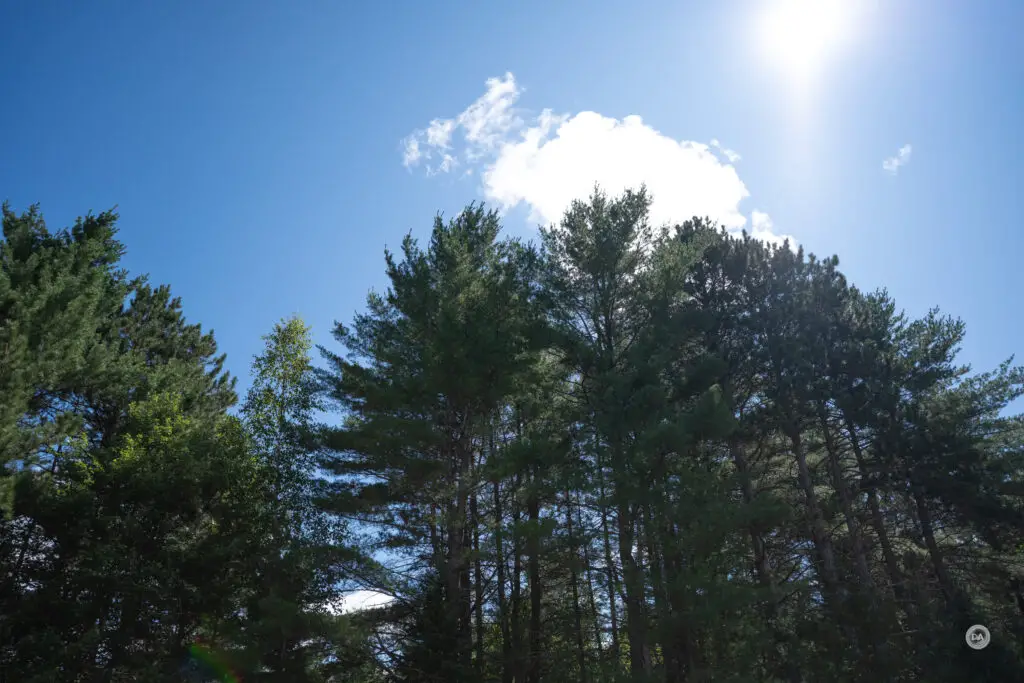
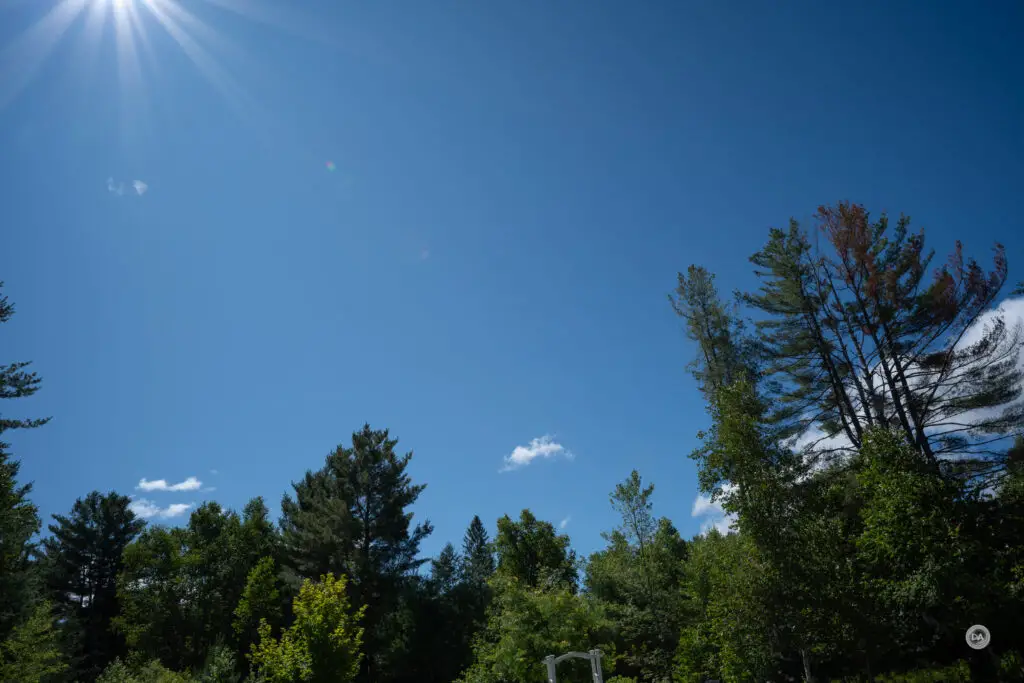


This isn’t really a “bokeh” kind of lens, but if you are close to your subject and background is relatively far away, bokeh isn’t bad.
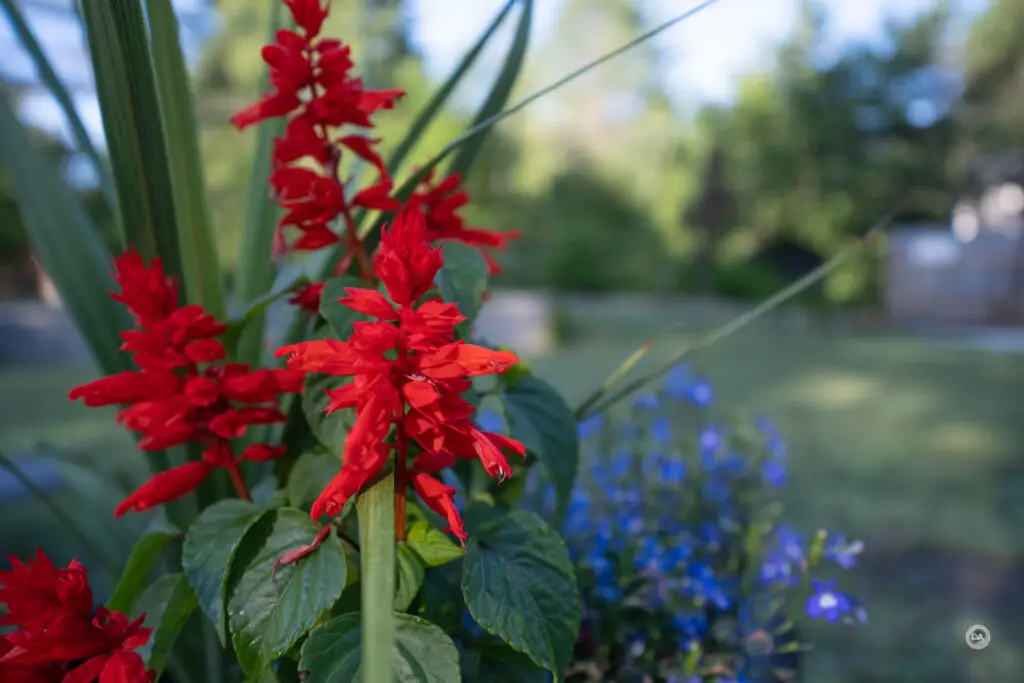
There is unfortunately some coma near the edges of the frame. You can see that the light points near the edge have become wedge shaped.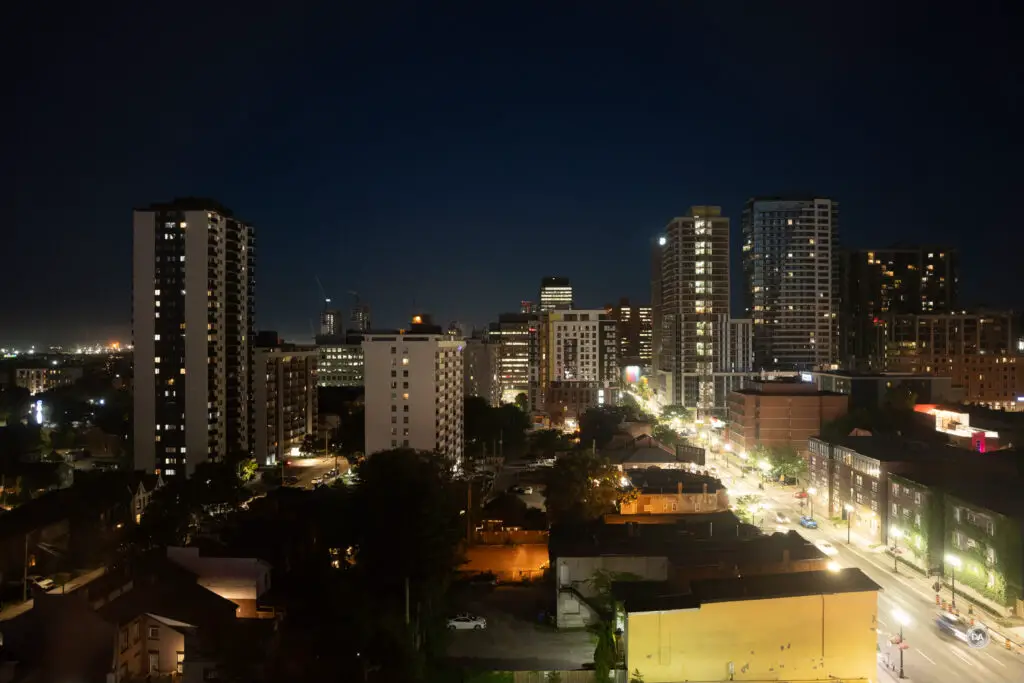
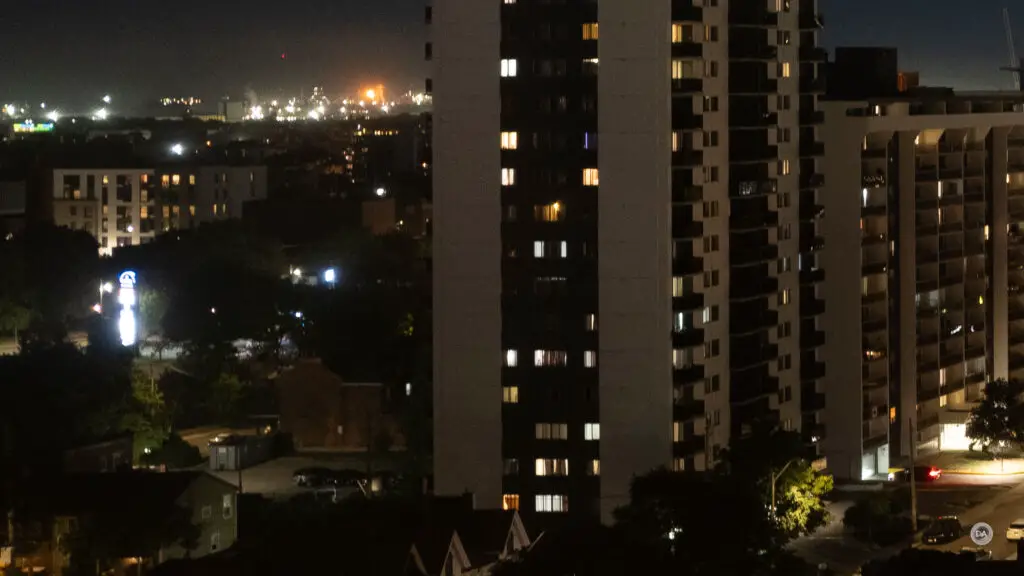
I wouldn’t consider this a high end astro lens, though there are worse options.
As per usual, this is another Viltrox AIR lens that is better optically than its price tag suggests. Here’s a gallery of images to enjoy.
I don’t feel like the AIR 15mm is quite as strong as the 25mm, but this is a much more challenging focal length, too, and I think that in general Viltrox pretty much nailed it once again.
Conclusion
I love the Viltrox AIR series. Lenses that are compact, lightweight, and yet deliver good image quality are near and dear to my heart because I know, practically, that they are far more likely to come along with me when I travel or backpack.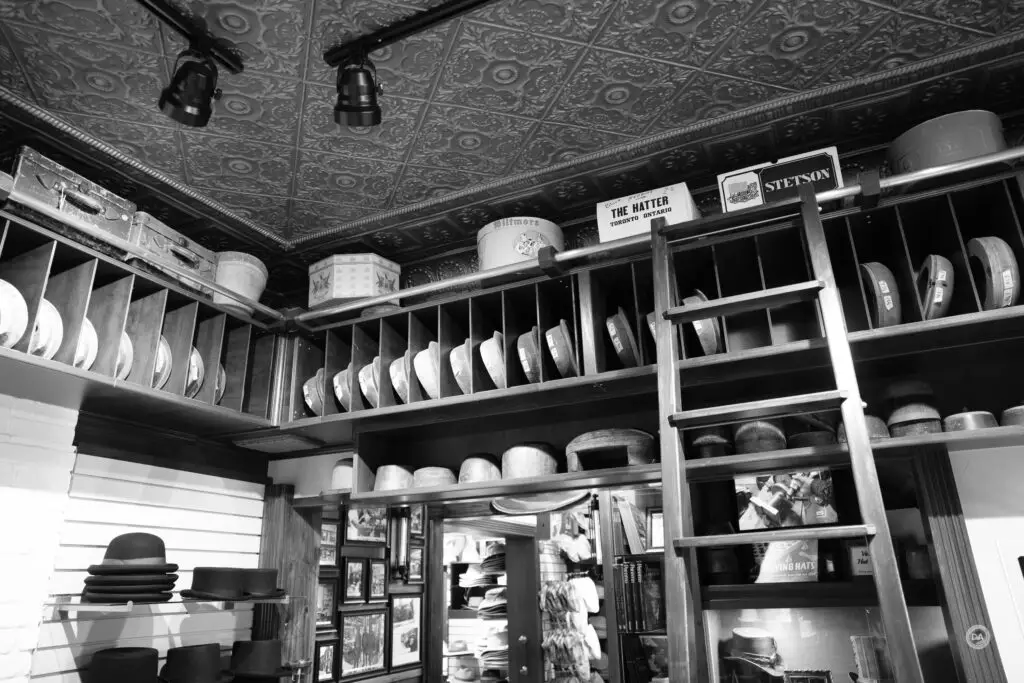
The Viltrox AIR 15mm F1.7 is the widest addition to their APS-C collection thus far, and I appreciate seeing a lens outside of the 23-56mm range where it feels like everyone has lenses now. It was a lot of fun to use for a wide variety of subjects.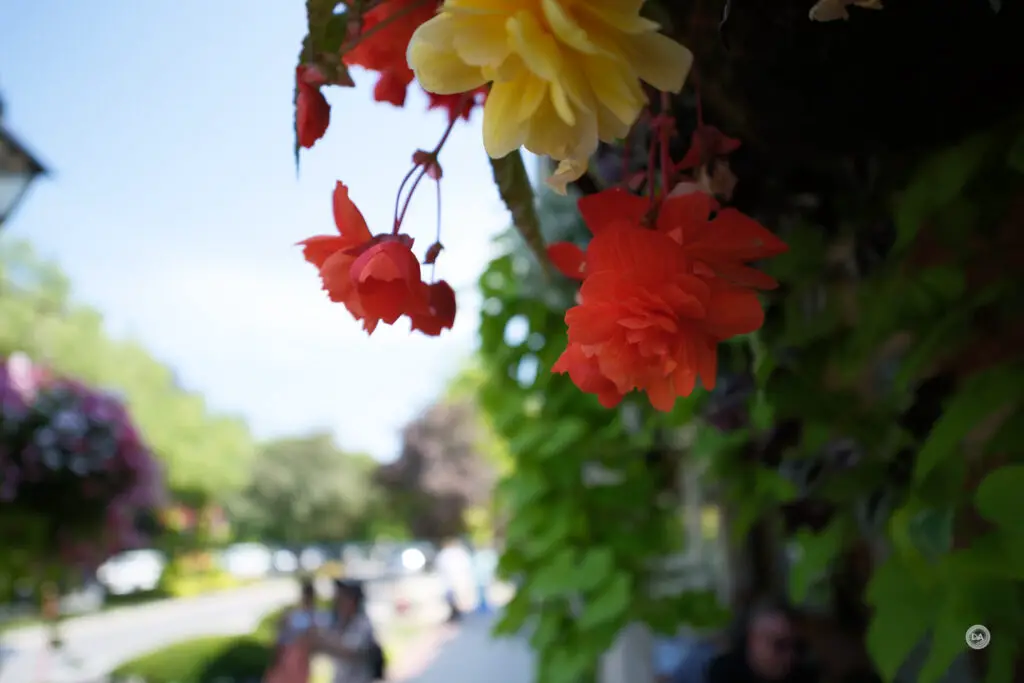
The AIR 15mm is a little more expensive than other lenses in the series at $239 USD, but that stands to reason as it also the most expensive focal length to engineer and manufacture thus far. When we look at alternative lenses in this focal length and aperture, however, we find that once again the Viltrox is a huge bargain. If you’ve been looking for a travel ready wide angle prime for your APS-C camera, the Viltrox AIR 15mm F1.7 should definitely be on your short list.
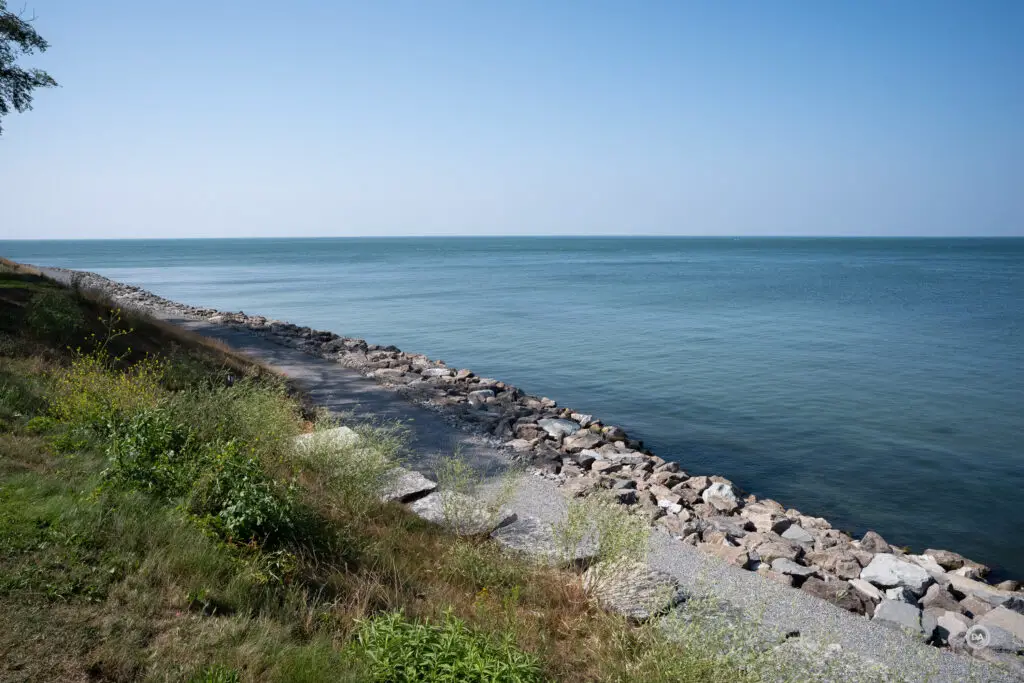
Pros:
- Lightweight, compact design
- Lens feels tough and well made
- USB-C port for firmware updates
- Good focus accuracy
- Pretty good video focus
- Outstanding center and midframe sharpness from F1.7
- Sharp across the frame at F5.6-F8
- Fairly low distortion
- Moderate vignette
- Good color rendering
- Much cheaper than alternate 14-16mm options
- Fantastic price to performance ratio
Cons:
- No weather sealing or features
- Some minor flare issues
- Some video AF quirks on Fuji
__________________________________________________________________________________________________
GEAR USED:
Purchase the Viltrox AF 15mm F1.7 @ Viltrox (use code DUSTINABBOTT for 5% off) | B&H Photo | Adorama | Amazon | Amazon Canada | Amazon UK | Amazon Germany | Vitopal | Pergear
_____________________________________________________________________________________________________________
Purchase the Viltrox AF 25mm F1.7 @ Viltrox (use code DUSTINABBOTT for 8% off) | B&H Photo | Adorama | Amazon | Amazon Canada | Amazon UK | Amazon Germany
___________________________________________________________________________________________________________
Purchase the Sony a6700 @ B&H Photo | Adorama | Amazon | Camera Canada | Sony Canada | Amazon Canada | Amazon UK | Amazon Germany
Purchase the Sony ZV-E10 II @ B&H Photo | Adorama | Amazon | Camera Canada | Amazon Canada | Amazon UK | Amazon Germany
___________________________________________________________________
Purchase the Sony a7RV @ B&H Photo | Adorama | Amazon | Camera Canada | Sony Canada | Amazon Canada | Amazon UK | Amazon Germany
___________________________________________________________________
Want to support this channel? Use these affiliate links to shop at: B&H Photo | Amazon | Adorama | Camera Canada | Amazon Canada | Amazon UK | Ebay | Make a donation via Paypal
Buy DA Merchandise https://bit.ly/TWIMerch
Keywords: Viltrox, Viltrox AIR 15mm F1.7, AIR, Viltrox AF, Viltrox 15mm, Viltrox 15mm F1.7, 25mm, 35mm, 56mm, F1.7, STM, AF, Fuji X-H2, X-T5, X-E5 APS-C, Sony a6700, ZV-E10 II, a6400, a7RV, Review, Review, Hands On, Dustin Abbott, Real World, Comparison, Sharpness, Bokeh, Flare Resistance, Autofocus, Image Quality, Sample Images, Video, Portrait, #viltrox, #letthelightin, #viltroxAF1715, #DA, #viltrox15air, #carrylesscapturemore, #viltrox15air, #viltroxAIR1715
DISCLAIMER: This article and description contains affiliate links, which means that if you click on one of the product links, I’ll receive a small commission. As an Amazon Associate I earn from qualifying purchases.










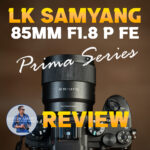 LK Samyang AF 85mm F1.8 P Review
LK Samyang AF 85mm F1.8 P Review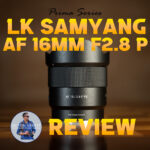 LK Samyang AF 16mm F2.8 Prima Review
LK Samyang AF 16mm F2.8 Prima Review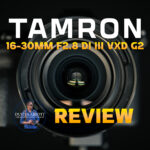 Tamron 16-30mm F2.8 Di III VXD G2 Review
Tamron 16-30mm F2.8 Di III VXD G2 Review GOOVIS ART Head Mounted Display Review
GOOVIS ART Head Mounted Display Review
